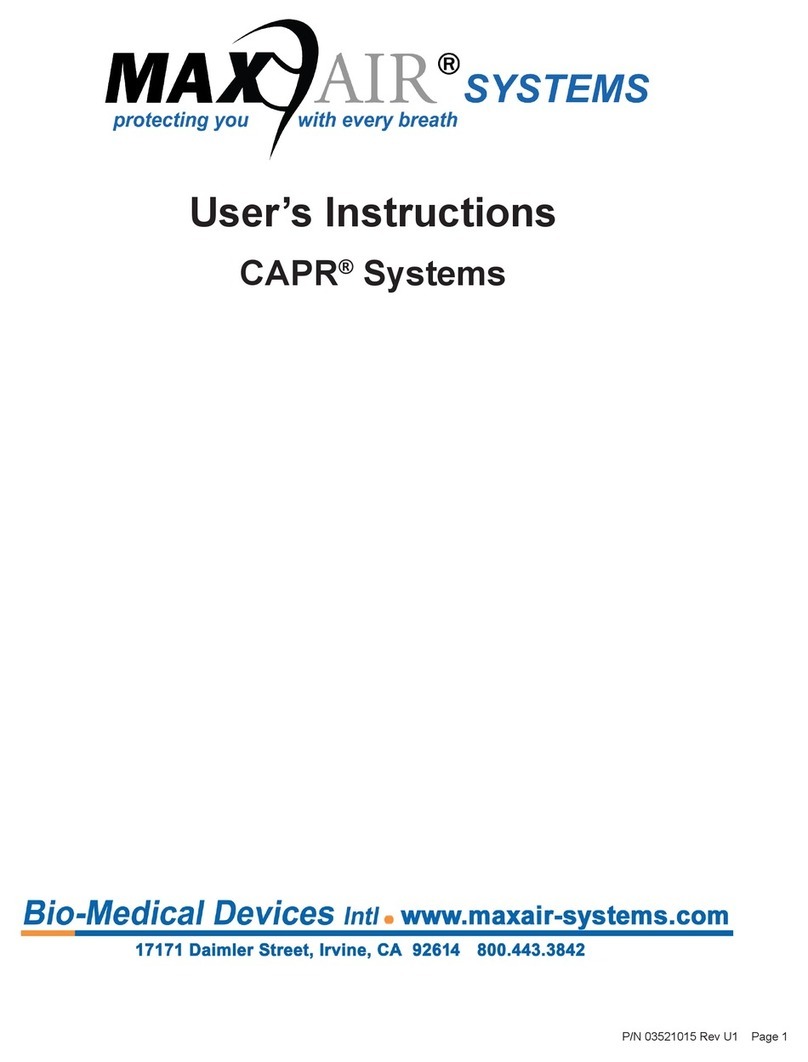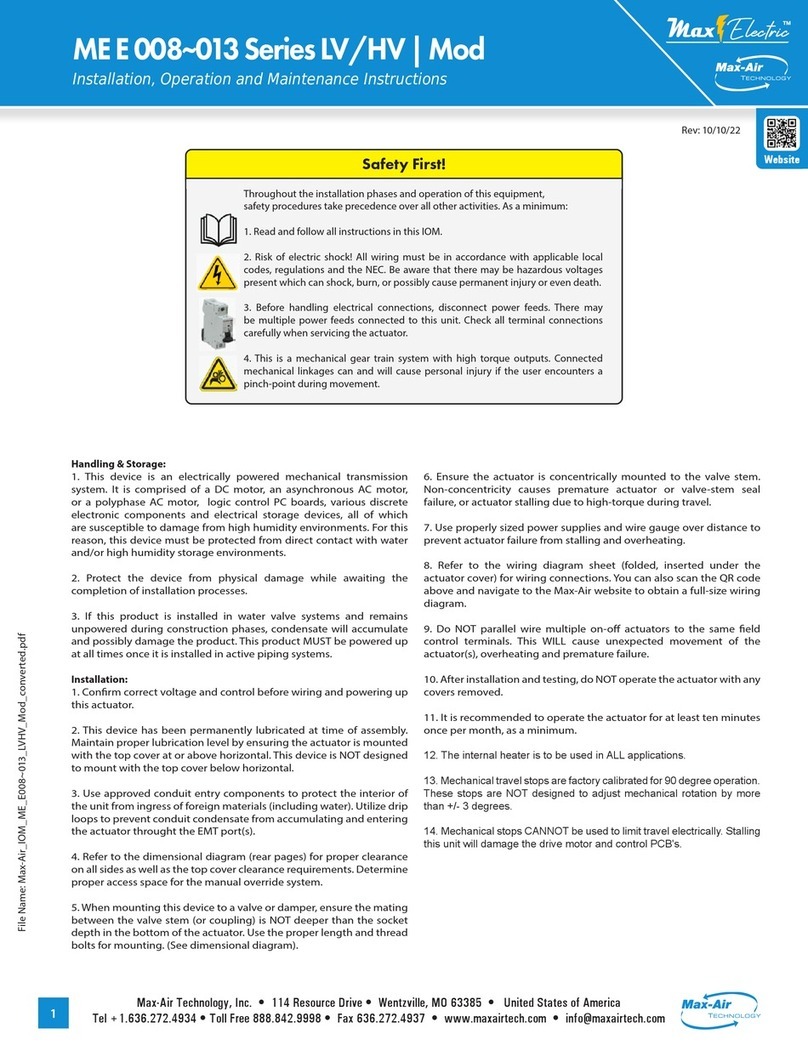
ME C 004 Series LV/HV | Mod
(con't) Installation, Operation and Maintenance Instructions
Rev: 10/10/22
Website
Max-Air Technology, Inc. • 114 Resource Drive • Wentzville, MO 63385 • United States of America
Tel
+1.636.272.4934
•
Toll
Free
888.842.9998
•
Fax
636.272.4937
•
www.maxairtech.com
•
[email protected]2
File Name: Max-Air_IOM_ME_G035~044_LVHV_Mod_converted.pdf
The purpose of the mechanical stops are for limiting the manual
override only!! Serious damage to the actuator will result if the
motor is allowed to drive the gear train into the mechanical stops!
This actuator has been factory calibrated to operate between 0° and
90°. Most quarter-turn products will not require recalibration of these
settings.
Default Operating Mode:
This actuator leaves the factory with the following default settings:
Input signal is 4-20mA, response is direct acting (20mA = full CCW - OPEN),
feedback is 4-20mA, Unit is set for 90° travel, and sensitivity is set at "3"
(0.5% full scale).
This manual is written for the proportional control actuators with DC drive
motors. (This is NOT the same as the power supply feeding the actuator).
This actuator must be calibrated prior to putting into service.
If this is a
stand-alone actuator, follow all the steps given here after mounting the
actuator to the driven device (valve, damper or other). If this actuator has
been factory mounted to the driven device, more than likely it has already
gone thru calibration and nothing further needs to be done.
1. The actuator normally ships in the full CW (Closed) position. This can
be veried by observing the location of the punched dimple in the main
output drive on the bottom of the actuator. The dimple should be pointing
towards the "0" in the lower housing casting. Use the handwheel to
reposition the output gear if the position is incorrect. (Fig 1)
2.
Do NOT apply power at this time.
3. Use a 17mm box wrench and a 5mm hex key to back out BOTH mechanical
stops. (Fig 2 & 3). Once the lock nut is loose, back out the stop screws by
3~4 full turns. Leave everything loose.
4.
Set the CW end of travel cam
.
a. Rotate the handwheel (CCW) to drive the actuator out to about 15~20
degrees open, then back to the desired CLOSED (CW) position. If you have
driven the device too far, you must drive back out to 10~15 degrees before
again approaching the correct CW stop. You cannot set the stop when
driving in a CCW direction due to cam dwell angle.
b. Using a 2.5mm hex key on CAM #2 (Fig 4), loosen the cam set screw and
rotate the cam CCW by pushing the hex key to the RIGHT a few degrees.
Lightly snug up on the set screw until resistance is felt against the cam
shaft. Pull the hex key to the LEFT SLOWLY until you hear a "click" from the
associated (#2) cam switch and snug up on the cam setscrew. Do not move
the actuator. No need to overtighten the cam setscrew.
5.
Set the CW auxiliary switch.
a. Using the 2.5mm hex key on CAM #4 (Fig 5) loosen the cam set screw and
rotate the cam CCW by pushing the hex key to the RIGHT a few degrees.
Lightly snug up on the set screw until resistance is felt against the cam
shaft. Pull the hex key to the LEFT SLOWLY until you hear a "click" from the
associated (#4) cam switch and continue a few more degrees in the same
direction. (This assures the AUX switch trips before the actuator reaches its
end of travel. Snug up on the cam setscrew.
6.
Set the CCW end of travel cam
.
a. Rotate the handwheel (CCW) to drive the actuator out to full OPEN
(CCW) to check for any obstructions in operation. Rotate the handwheel
back to about 75~80 degrees open, and then back to the desired OPEN
(CCW) position. If you have driven the device too far, you must drive back
out to 75~80 degrees before again approaching the correct CCW stop. You
cannot set the stop when driving in a CW direction due to cam dwell angle.
b. Using a 2.5mm hex key on CAM #1 (Fig 6), loosen the cam set screw
and rotate the cam CW by pushing the hex key to the LEFT a few degrees.
Lightly snug up on the set screw until resistance is felt against the cam
ME G 035~044 Series LV/HV | Mod
(con't) Installation, Operation and Maintenance Instructions
Fig 1 - Bottom view of actuator showing the “0”
mark (Closed [CW] position), the “1” mark (Open
[CCW] position), and the dimple reference. The
actuator is shipped from the factory in its fully
CLOSED position.
Fig 3 - Left side (CCW) mechanical stop
Fig 2 - Right side (CW) mechanical stop
Fig 4 - CW EOT Cam adjustment
Fig 5 - CW AUX Cam adjustment























